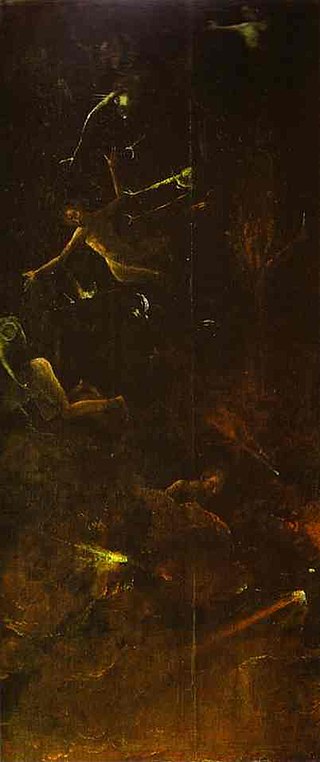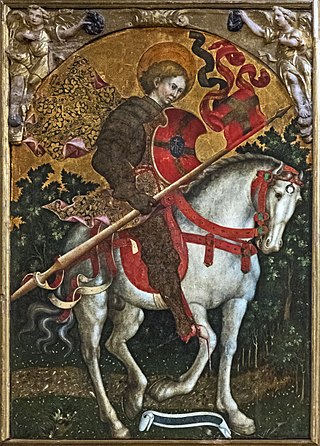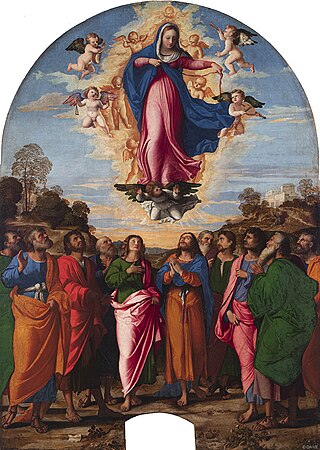
Hieronymus Bosch was a Dutch painter from Brabant. He is one of the most notable representatives of the Early Netherlandish painting school. His work, generally oil on oak wood, mainly contains fantastic illustrations of religious concepts and narratives. Within his lifetime, his work was collected in the Netherlands, Austria, and Spain, and widely copied, especially his macabre and nightmarish depictions of hell.

Ship of Fools is a painting by the Early Netherlandish artist Hieronymus Bosch, now in the Musée du Louvre, Paris. Camille Benoit donated it in 1918. The Louvre restored it in 2015. The surviving painting is a fragment of a triptych that was cut into several parts. This piece, originally part of a larger body of work relating to the seven deadly sins, depicts the sin of gluttony. The Ship of Fools was painted on one of the wings of the altarpiece, and is about two-thirds of its original length. The bottom third of the panel belongs to Yale University Art Gallery and is exhibited under the title Allegory of Gluttony. The other wing, which has more or less retained its full length, is the Death and the Miser, now in the National Gallery of Art, Washington, D.C. The two panels together would have represented the two extremes of prodigality and miserliness, condemning and caricaturing both. The Wayfarer (Rotterdam) was painted on the right panel rear of the triptych. The central panel, if it existed, is unknown.

The Gallerie dell'Accademia is a museum gallery of pre-19th-century art in Venice, northern Italy. It is housed in the Scuola della Carità on the south bank of the Grand Canal, within the sestiere of Dorsoduro. It was originally the gallery of the Accademia di Belle Arti di Venezia, the art academy of Venice, from which it became independent in 1879, and for which the Ponte dell'Accademia and the Accademia boat landing station for the vaporetto water bus are named. The two institutions remained in the same building until 2004, when the art school moved to the Ospedale degli Incurabili.

The Garden of Earthly Delights is the modern title given to a triptych oil painting on oak panel painted by the Early Netherlandish master Hieronymus Bosch, between 1490 and 1510, when Bosch was between 40 and 60 years old. Bosch's religious beliefs are unknown, but interpretations of the work typically assume it is a warning against the perils of temptation. The outer panels place the work on the Third Day of Creation. The intricacy of its symbolism, particularly that of the central panel, has led to a wide range of scholarly interpretations over the centuries.

Giovanni Battista Cima, also called Cima da Conegliano, was an Italian Renaissance painter, who mostly worked in Venice. He can be considered part of the Venetian school, though he was also influenced by Antonello da Messina, in the emphasis he gives to landscape backgrounds and the tranquil atmosphere of his works.

Terrestrial Paradise is a painting by Netherlandish artist Hieronymus Bosch, dating from around 1490. It is now in the Gallerie dell'Accademia in Venice, Italy. The painting depicts Terrestrial Paradise, where the remaining sins of the saved were washed away. The Fountain of Life stands on top of the hill.

Fall of the Damned into Hell is a painting by the Early Netherlandish artist Hieronymus Bosch made sometime before 1490. It is currently in the Gallerie dell'Accademia in Venice, Italy.

Hell is an oil-on-panel painting executed after 1490 by the Dutch artist Hieronymus Bosch. It is currently in the Gallerie dell'Accademia in Venice, Italy.

The Crucifixion of Saint Wilgefortis is a c. 1497 triptych by the Early Netherlandish painter Hieronymus Bosch. The subject of the painting has been uncertain, and it has also been known as the Triptych of the Crucified Martyr, or The Crucifixion of Saint Julia, but is now believed to depict Saint Wilgefortis.

The Hermit Saints is a religious oil on panel painting displayed as a triptych which was painted c. 1493 by the Early Netherlandish artist Hieronymus Bosch. The entirety of the triptych painting measures 86 by 60 centimetres. This artwork is currently being housed at the Gallerie dell'Accademia, Venice.

Michele Taddeo di Giovanni Bono, known as Giambono was an Italian painter, whose work reflected the International Gothic style with a Venetian influence. He designed the mosaics of the Birth of the Virgin and Presentation in the Temple. His best known paintings are the Man of Sorrows and the St. Peter.

The Last Judgment is a triptych by the Early Netherlandish artist Hieronymus Bosch, created after 1482.

The Scuola Grande di San Giovanni Evangelista is a confraternity building located in the San Polo sestiere of the Italian city of Venice. Founded in the 13th century by a group of flagellants it was later to become one of the five Scuole Grandi of Venice. These organisations provided a variety of charitable functions in the city as well as becoming patrons of the arts. The Scuola Grande di San Giovanni Evangelista is notable for housing a relic of the true cross and for the series of paintings it commissioned from a number of famous Venetian artists depicting Miracles of the Holy Cross. No longer in the school, these came into public ownership during the Napoleonic era and are now housed in the Gallerie dell'Accademia. The scuola is open to visitors on a limited number of days, detailed on the official website.

Ludwig von Baldass was an Austrian art historian, professor and acclaimed author who specialised in Early Netherlandish painting. He studied under Max Dvořák at the University of Vienna and began to lecture there in 1926, gaining the position of professor in 1934. Von Baldass' 1942 treatise on Hans Memling was instrumental in the re-evaluation of his artistic importance. Other publications include articles and books on Jan van Eyck (1952), Hieronymus Bosch (1953), Giorgione and Albrecht Altdorfer.

The Last Judgment is a triptych of disputed authorship, either by the Early Netherlandish master Hieronymus Bosch, his workshop, or a collaboration between artist and workshop. It was created after 1486. It is one of eight surviving triptychs by Bosch.

Hieronymus Bosch, Touched by the Devil is a 2015 Dutch documentary film directed by Pieter van Huystee about the Dutch artist Hieronymus Bosch. It documents how The Haywain Triptych is exhibited in Bosch's hometown of 's-Hertogenbosch for the first time in almost 500 years.

The Fall of the Damned is an oil on panel painting by the Early Netherlandish painter Dieric Bouts, completed in 1470. It was produced as the rightmost section of a triptych of a Last Judgment scene commissioned for the town hall of Louvain, Belgium, in 1468. The central panel of the triptych is lost, but the left side panel, the Ascension of the Elect, survives along with the Fall of the Damned. The set of images would have drawn narrative inspiration from Genesis 2:10, the Book of Revelation and from the Purgatory of St Patrick, a 14th-century Irish manuscript by Berol telling of Sir Owein's legendary trip to Purgatory. The Fall has been on permanent loan from the Louvre to the Palais des Beaux-Arts de Lille, where it has been reunited with the Ascension since 1957.

Adam and Eve, also known as The Temptation of Adam, Original Sin, and The Fall of Man, may refer to either of two similar works by the Venetian painter Tintoretto: an oil painting in the collection of the Gallerie dell'Accademia in Venice, made around 1550–1553; and a panel in the ceiling of the Upper Hall of the Scuola Grande di San Rocco, made around 1577–1578.

The Assumption of the Virgin is an oil on panel painting by Palma Vecchio, created c. 1513, now in the Gallerie dell'Accademia in Venice.



















